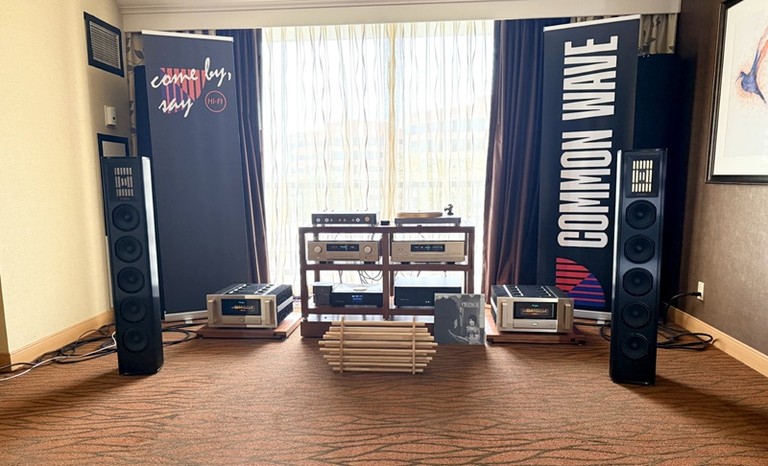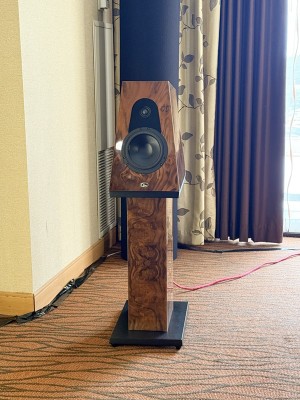T.H.E. Show SoCal 2025: Hi-Fi Audio & Speakers Part IV
Piega, Accuphase, and Thales
In one of six rooms sponsored by Los Angeles retailer Common Wave HiFi, I had the opportunity to hear the Swiss-made Piega Coax 611 loudspeakers ($20K/pair) for the first time. I was so intrigued by the speaker’s design, which has a 1x2-inch ribbon tweeter mounted concentrically within an 8x6.5-inch planar midrange driver, that I returned to this room twice, after being thwarted by conversation the first time and someone in the midst of filming a video the second time. The pricey analog front end, also from Switzerland, included the Thales Reference turntable ($50K) and Thales Magnifier phono preamp ($50K).
For digital, a Grimm Audio streamer fed a digital signal to an Accuphase DP770 MDSD SACD player/DAC ($26,575), which includes a made-in-house floating transport. The Accuphase C2900 preamp ($25,975) and A300 monoblock amplifiers ($25,975 each) fed the speakers with 125 watts of very lovely-sounding Class A power. An IsoTek V5 Sigmas power conditioner ($4,850) and room treatments from ASC and Onkyo AGS Acoustics completed the system. Each of the Piega Coax 611 speakers uses a pair of 6-inch woofers and a trio of 6-inch passive radiators to extend the frequency response of the planar coax unit, which itself plays down to 450Hz, according to Piega. But on both “Stay Awake” by London Grammar and “Perfect Darkness (Live from Union Chapel)” by Fink, the sound was remarkably coherent, as if being recreated by a single driver with no crossover. Unlike most single-driver speakers, however, this system delivered remarkable clarity in the high frequencies, making percussive sounds like snare drum rims and cymbal bells appear true-to-life and rich in harmonic information. Vocals were presented with a wealth of texture. I left the room with a continuing admiration for Accuphase and some major incentive to spend more time with Piega speakers in the future.
Luxman and QLN
If pressed to choose a favorite of the Common Wave HiFi rooms, it would have to be the Luxman room, which featured the Japanese brand’s Black-Edition CENTENNIAL system. A collection of components finished in a gorgeous black instead of Luxman’s signature silver, this system includes the Luxman PD-151 Mark II turntable ($5,995 plus $2,695 for the Luxman LMC-5 moving coil cartridge), NT-07 streaming transport ($7,995), and D-07X SACD player/DAC ($10,495), all connected to a Luxman L-509Z integrated amplifier ($12,995), which looks especially good in black.
The speakers were the QLN Signature (with integrated stands, $24,500/pair), a beautifully-built Swedish 2-way. The system also included a Luna Cables Rouge step-up transformer ($4,850), an IsoTek V5 Sigmas power conditioner ($4,850), a lovely wooden audio rack from Box Furniture Co., and room treatments from ASC and Onkyo AGS Acoustics. Cables were from Luna Cables and IsoTek.
Despite a beautiful Walnut Burl finish, the QLN speakers don’t look especially unusual; they use a 1-inch soft dome tweeter and a 7 ¼-inch kevlar mid-woofer, arranged as you’d expect, housed in a substantial cabinet shaped like a truncated pyramid. Each speaker weighs 68 pounds, according to QLN. But although there was nothing obviously radical about the look of the speakers, the whole system sang with a natural, organic quality that felt truly special and led me to write “I could listen to this all day!” in my notes. The song “Birds” by Dominique Fils-Aimé features multiple vocal tracks (which begin in unison but an octave apart) accompanied by upright bass and punctuated by finger snaps and other delicate percussion sounds. The sparse arrangement was aided by the system’s apparently low noise-floor in creating a sense of tension that was almost spine-tingling. “Make Me Feel” by Janelle Monáe has a more playful mood. A sense of high resolution carried over from the previous track, evident in the close-miked tongue-clicking sounds and super-clear vocals. But the fat-sounding synth bass on this Prince-inspired song made it clear that this system wasn’t just about audiophile elegance; it could also get down and boogie. On Elvis’s 1960 recording of “Fever,” everything from the finger snaps to the quiet (yet somehow funky) upright bass part was in perfect balance, with dueling drummers D.J. Fontana and Buddy Harman having a perfectly-timed conversation in the left and right channels. This was a standout system. Like the Piega speakers, this experience with QLN left me wanting to hear more from a new-to-me — but otherwise well-established — loudspeaker brand. I expect that many Luxman fans will be disappointed to learn (as I was) that the only way to buy one of these Black Edition CENTENNIAL pieces is to buy the entire CENTENNIAL system for about $37K; they are not available à la carte.
Rockport and CH Precision
In one of two rooms hosted by local dealer Sunny Components, CH Precision’s Kevin Wolff played the most memorable musical selections I heard all weekend, on a system with Best-In-Show sound quality. I had a great time in this demo. The system featured the new Rockport Technologies Lynx loudspeakers ($78,000/pair and up, depending on finish), which were making their West Coast premiere, powered by a suite of gear from Switzerland’s CH Precision. The digital sources included the D 1.5 SACD/CD transport ($39,000), the T1 10MHz Time Reference clock ($25,500), and the C10 2-box DAC ($95,000), which was making its US premiere at T.H.E. Show. On the analog side, a Brinkmann Audio Taurus turntable ($20,490) was fitted with an Acoustical Systems Aquilar tonearm ($14,500) and an Acoustical Systems Archon cartridge ($4,500), feeding a CH Precision P1 phono stage ($31,000). The rest of the CH Precision stack included the L1 preamplifier ($34,500), the X1 dual power supply ($21,500) and the M 1.1 stereo power amp ($57,000). Extensive power conditioning was provided by Shunyata Research. Equipment racks were from Harmonic Resolution Systems, and the megabuck loom of cabling was from Audioquest.
Wolff started the demo by playing “There'll Be Peace in the Valley (takes 2-3)” by Elvis on SACD. This 1957 recording from the early days of stereo had no center image, placing Elvis alone in the left channel and the backup singers in the right channel delivering tight harmonies. This type of recording can be jarring on some systems — ever listen to an early “stereo” Beatles record on headphones? — but it was a revelation on the new Rockport Lynx speakers powered by CH Precision. Other than some slight tape hiss, the pristine recording sounded as if it had just been captured moments ago, and it brought Elvis to life in a way I had never heard before. I’m only a casual Elvis fan, but this was easily the most musically-moving experience I had at T.H.E. Show. Moving over to vinyl, we listened to “Awards Season” by Bon Iver. The reverb surrounding Justin Vernon’s baritone voice on this somewhat strange-sounding recording placed the listener right next to him in whatever cramped space the singer was recording in. When a cacophonous band of saxophones joined in, each instrument could be heard and followed individually. Even though there was no apparent method to the madness, the saxes didn’t blur together on this spectacularly-resolving system.
Next came a wonderful live recording of Etta James from the Montreux Jazz Festival in 1989. “Medley: At Last / Trust Me / Sunday Kind Of Love” made it clear that the Rockport speaker cabinets are absolutely silent, contributing to a frankly insane level of transparency, especially considering the fact that this was not some intricately-engineered audiophile recording. It seemed as if the sound were coming directly from the air molecules in the room, with nothing between Etta’s voice and my ears. Interestingly, this was being played from an MQA CD — a format that never caught on outside of Japan, to my knowledge, but which the CH Precision D 1.5 transport is nevertheless capable of playing. Finally, we listened to “What’s New” by Boz Scaggs, whose bigger-than-life voice filled the room alongside a tonally-lifelike saxophone. Even though this was a redbook CD and not a high-resolution recording, the overtones on the drummer’s ride cymbal were laid bare as if we were hearing a live microphone feed. Overall, a stunning showing from CH Precision and Rockport.
Harbeth and Mola Mola
There were some rooms that I simply wasn’t able to evaluate because folks were talking during the demos I tried to attend. Even though I could tell from poking my head in that these systems were promising, I had to skip a Common Wave HiFi room that featured smaller Piega stand-mounts, and a Sunny Components room that featured smaller Rockport floor-standers. But because there was only one room at the whole show featuring Harbeth speakers (which I tend to enjoy very much), I made a second trip to the Harbeth room after the first attempt was a bust. This room, also hosted by Common Wave HiFi, contained a much smaller system than the CH Precision Rockport system described above. The Harbeth system would be easy to accommodate in a small living room, thanks in part to the manageable size of the 2-way Harbeth M30.3 XD2 loudspeakers ($6,190/pair). These were driven by equally compact electronics from Mola Mola, including the Tambaqui DAC ($13,500), the Makua preamp with phono stage ($15,200), and the Perca stereo power amp ($9,850). The turntable was a Reed Muse 1C Friction Drive Turntable in Karelian Birch finish (starting at $17,995; as shown with the Reed 3P 12” Ebony Cryo AG-4N tonearm, $25,569). The system also included a Shunyata Research Eiger 6/T power conditioner ($5K), Shunyata Research cables, and ASC room treatments. “Perfect Darkness (Live)” by Fink was played in a lot of rooms, and on this system it sounded brighter than I had come to expect after hearing it all weekend. Bright sound is not what I have come to expect from Harbeth speakers, so that came as a surprise. “Rise” by Dominique Fils-Aimé sounded much bigger than I would have predicted from a pair of small 2-ways, and the “just right” timbre of the singer’s voice is something I definitely do associate with Harbeths. On “You Look Good to Me” by Oscar Peterson Trio, Ray Brown’s delicate touch on the bass was communicated with nuance and subtlety by this tidy little system. Ed Thigpen’s brushwork on the snare drum was brimming with texture, but despite this level of detail retrieval, the system didn’t exaggerate any part of the frequency spectrum enough to draw attention away from the musical whole. While there was no deep bass, this was still a satisfying system.
Stay tuned for the exciting conclusion to our coverage of T.H.E. Show SoCal 2025!








